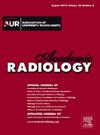Diagnostic Accuracy of Dual-Energy CT-Derived Metrics for the Prediction of Osteoporosis-Associated Fractures
IF 3.8
2区 医学
Q1 RADIOLOGY, NUCLEAR MEDICINE & MEDICAL IMAGING
引用次数: 0
Abstract
Rationale and Objectives
This study aimed to compare the diagnostic value of dual-energy CT (DECT)-based volumetric material decomposition with that of Hounsfield units (HU)-based values and cortical thickness ratio for predicting the 2-year risk of osteoporosis-associated fractures.
Methods
The L1 vertebrae of 111 patients (55 men, 56 women; median age, 62 years) who underwent DECT between 01/2015 and 12/2018 were retrospectively analyzed. For phantomless bone mineral density (BMD) assessment, a specialized DECT postprocessing software employing material decomposition was utilized. The digital records of all patients were monitored for two years after the DECT scans to track the incidence of osteoporotic fractures. Diagnostic accuracy parameters were calculated for all metrics using receiver-operating characteristic (ROC) and precision-recall (PR) curves. Logistic regression models were used to determine associations of various predictive metrics with the occurrence of osteoporotic fractures.
Results
Patients who sustained one or more osteoporosis-associated fractures in a 2-year interval were significantly older (median age 74.5 years [IQR 57–83 years]) compared those without such fractures (median age 50.5 years [IQR 38.5–69.5 years]). According to logistic regression models, DECT-derived BMD was the sole predictive parameter significantly associated with osteoporotic fracture occurrence across all age groups. ROC and PR curve analyses confirmed the highest diagnostic accuracy for DECT-based BMD, with an area under the curve (AUC) of 0.95 [95% CI: 0.89–0.98] for the ROC curve and an AUC of 0.96 [95% CI: 0.85–0.99] for the PR curve.
Conclusion
The diagnostic performance of DECT-based BMD in predicting the 2-year risk of osteoporotic fractures is greater than that of HU-based metrics and the cortical thickness ratio. DECT-based BMD values are highly valuable in identifying patients at risk for osteoporotic fractures.
预测骨质疏松症相关骨折的双能量 CT 衍生指标的诊断准确性。
依据和目的:本研究旨在比较基于双能 CT(DECT)的体积物质分解与基于 Hounsfield 单位(HU)值和皮质厚度比的诊断价值,以预测骨质疏松症相关骨折的 2 年风险:对2015年1月至2018年12月期间接受DECT检查的111名患者(55名男性,56名女性;中位年龄62岁)的L1椎体进行回顾性分析。为了进行无假体骨矿物质密度(BMD)评估,使用了一款采用材料分解技术的专业 DECT 后处理软件。在 DECT 扫描后的两年内,对所有患者的数字记录进行了监测,以跟踪骨质疏松性骨折的发生率。所有指标的诊断准确性参数均采用接收器操作特征曲线(ROC)和精确度-召回曲线(PR)进行计算。使用逻辑回归模型确定各种预测指标与骨质疏松性骨折发生率的关系:结果:与未发生骨折的患者(中位年龄 50.5 岁 [IQR 38.5-69.5 岁])相比,两年内发生一次或多次骨质疏松症相关骨折的患者年龄明显偏大(中位年龄 74.5 岁 [IQR 57-83 岁])。根据逻辑回归模型,在所有年龄组中,DECT 导出的 BMD 是与骨质疏松性骨折发生率显著相关的唯一预测参数。ROC和PR曲线分析证实,基于DECT的BMD诊断准确性最高,ROC曲线的曲线下面积(AUC)为0.95 [95% CI:0.89-0.98],PR曲线的AUC为0.96 [95% CI:0.85-0.99]:结论:基于 DECT 的 BMD 在预测 2 年骨质疏松性骨折风险方面的诊断性能高于基于 HU 的指标和皮质厚度比。基于 DECT 的 BMD 值在识别骨质疏松性骨折风险患者方面具有很高的价值。
本文章由计算机程序翻译,如有差异,请以英文原文为准。
求助全文
约1分钟内获得全文
求助全文
来源期刊

Academic Radiology
医学-核医学
CiteScore
7.60
自引率
10.40%
发文量
432
审稿时长
18 days
期刊介绍:
Academic Radiology publishes original reports of clinical and laboratory investigations in diagnostic imaging, the diagnostic use of radioactive isotopes, computed tomography, positron emission tomography, magnetic resonance imaging, ultrasound, digital subtraction angiography, image-guided interventions and related techniques. It also includes brief technical reports describing original observations, techniques, and instrumental developments; state-of-the-art reports on clinical issues, new technology and other topics of current medical importance; meta-analyses; scientific studies and opinions on radiologic education; and letters to the Editor.
 求助内容:
求助内容: 应助结果提醒方式:
应助结果提醒方式:


